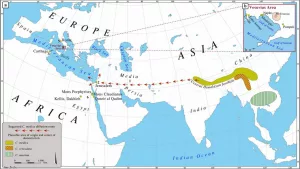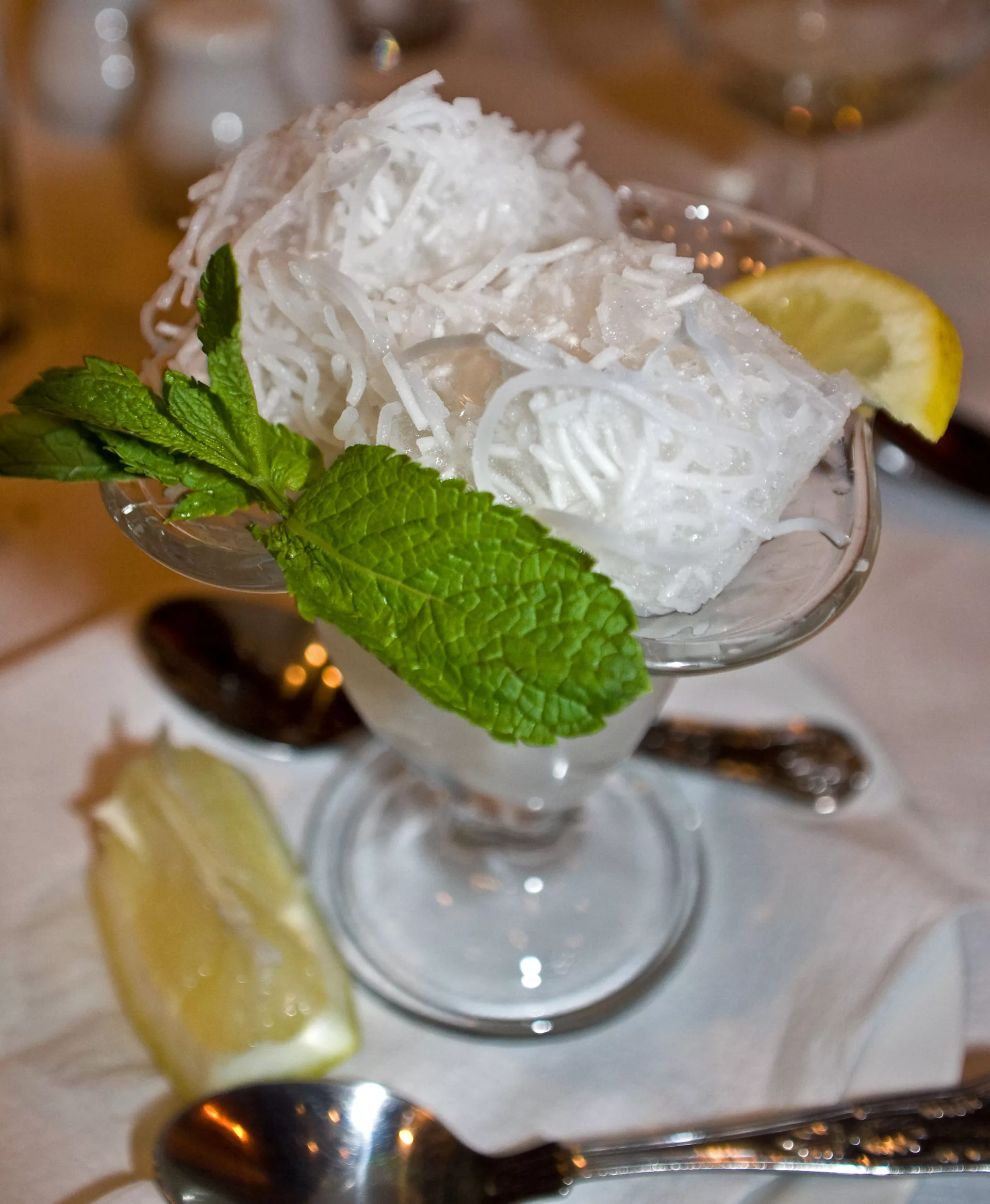Connections – Food – Life – History
By Mary Stanley
The story of frozen desserts starts in China with citrus (orange, lime, lemon, grapefruit, citron). Citrus is not native to either Europe or the Americas. Citrus originated in southeast Asia. It’s route to Europe and Arabic parts of northern Africa can be traced through art, ancients texts, coins, pollen, seeds and other botanical remains found in archaeological digs. The first to arrive in Persia was found in the royal garden near Jerusalem around fifth and fourth centuries B.C. This was approximately the era of the Achaemenid and Sassanian Persian Empires. We’ll just call it Persia which at that time stretched across the area we now call Turkey and Iran all the way to western India. This diverse iron age “kingdom” became the center for science, medicine, and the Zoroastrian religion – a golden era until warring factions tore it apart. Too many begats and tribes to cover here. We’re talking about food, not politics and war, though both have an effect on what and how we eat.

Further proof of the connection between Persia and China 126 BC to 500 A.D. is historical evidence concerning trade and diplomatic contact between the two. The Sassanians sent dozens of emissaries to China 400-500 CE. The largest of the embassies…numbered several hundred persons, while even the smaller parties included over 100 members. Persian musicians, art, and wine merchants were popular in China. Large caches of Sassanian coins can be found in China from this period. You can purchase one of these coins today on Ebay though I won’t vouch for it’s authenticity. It was through cultural and material trade that spinach (called the Persian vegetable) and grapes were introduced to the Chinese while citrus was introduced to the Persians. The word spinach is derived from Persian (espanâx). These food connections show the profound influence of the history of both ancient cultures on our modern kitchen tables.
The westward migration, of citrus species which is what we are especially interested in because of it’s use as a flavoring agent for a wide variety of foods, goes something like below. You can see how other empires played their part in spreading the cultivation of citrus for food and medicine over the centuries. By 400 BC, Persians had developed the “yakhchal” or an ancient freezer. Ice was gathered during the winter or brought down from the mountains then stored in large insulated underground chambers topped by dome structures. This allowed them to store ice even in the summer in the desert. The great grandparent of frozen desserts which provided the basis of all ice creams, sorbets and gelatos is this ancient Persian mixture, a recipe which I provide below. Originally they just used ice, honey, and various flavors, saffron and fruits. Rose water was added after distillation techniques became available. As sugar cane was discovered, it began to substitute for honey. (You will not believe the effect that distillation and alcohol had on the history of frozen yummy desserts, to be covered in Part Five of this series, when American Prohibition caused breweries to go out of business and needed to find a new source of income by making a cold pivot)

At some point Persians began mixing home made noodles into the ice. Faludeh are made with a thin rice batter that is pressed through a sieve to produce delicate noodles that look like grated coconut. Today most people in former Persian areas use rice vermicelli. When cooked the noodles are stirred into sweetened shaved ice flavored with a little lime juice and rose water, then it is sprinkled with chopped pistachios. The Indian version is called “kulfi”. “Faludeh sib” is a variation substituting grated apples for noodles.

Faludeh – Persian Rose Sorbet with Rice Noodles
6-8 servings
4 cups water
1 1/2 cups sugar
2 Tablespoons fresh lime or lemon juice
8 ounces thin rice noodles or Chinese rice sticks broken into 1-inch pieces
1. In a medium sauce pan dissolve the sugar in the water over low heat. Be sure no crystals remain or your sorbet will turn grainy. Increase the heat to a boil then turn it off and let it cool. Stir in the lime juice and rose water. Pour into ice cube trays and freeze.
2. Soak the noodles in cold water for an hour. Drain, then boil in fresh water until tender but not mushy, 3 to 5 minutes. Drain again, rinse with cold water to stop the cooking and drain again, Refrigerate until chilled.
3. Crush the frozen flavored sugar syrup from step one, or spin in a blender until you have slush, vigorously stir in the noodles, serve in bowls or if using later, freeze then soften by crushing it with a spoon. A tart cherry syrup over the top is a nice finishing touch.
Note: this recipe is both gluten and dairy free!
Who were the Sasanian Dynasty (224–651 C.E.). The Sasanians were the last pre-Islamic Iranian dynasty who ruled an expansive empire stretching across western and central Asia. The Sasanians called their empire Eranshahr, the Empire of the Iranians. Much of the material culture that survives is court art, that is, luxury objects and royal monuments created and used by the empire’s ruling and elite strata of society.
The owners of luxury items like the royal hunting plate, passed their possessions on through many hands, whether as heirlooms, gifts, or barter. Many Sasanian luxury goods traveled extensively across the Eurasian landmass, ultimately landing in locations that range from French church treasuries and Chinese collectors.
Mary Stanley is a local writer and the owner of The Turtle Restaurant in Brownwood whose columns will appear periodically on the website.
